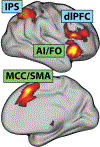Dispositional negativity, cognition, and anxiety disorders: An integrative translational neuroscience framework
- PMID: 31196442
- PMCID: PMC6578598
- DOI: 10.1016/bs.pbr.2019.03.012
Dispositional negativity, cognition, and anxiety disorders: An integrative translational neuroscience framework
Abstract
When extreme, anxiety can become debilitating. Anxiety disorders, which often first emerge early in development, are common and challenging to treat, yet the underlying mechanisms have only recently begun to come into focus. Here, we review new insights into the nature and biological bases of dispositional negativity, a fundamental dimension of childhood temperament and adult personality and a prominent risk factor for the development of pediatric and adult anxiety disorders. Converging lines of epidemiological, neurobiological, and mechanistic evidence suggest that dispositional negativity increases the likelihood of psychopathology via specific neurocognitive mechanisms, including attentional biases to threat and deficits in executive control. Collectively, these observations provide an integrative translational framework for understanding the development and maintenance of anxiety disorders in adults and youth and set the stage for developing improved intervention strategies.
Keywords: Affective neuroscience; Amygdala; Attentional biases; Developmental psychopathology; Emotion; Fear and anxiety; Individual differences; Neuroimaging.
© 2019 Elsevier B.V. All rights reserved.
Figures







Similar articles
-
The neurobiology of dispositional negativity and attentional biases to threat: Implications for understanding anxiety disorders in adults and youth.J Exp Psychopathol. 2016;7(3):311-342. doi: 10.5127/jep.054015. J Exp Psychopathol. 2016. PMID: 27917284 Free PMC article.
-
A translational neuroscience approach to understanding the development of social anxiety disorder and its pathophysiology.Am J Psychiatry. 2014 Nov 1;171(11):1162-73. doi: 10.1176/appi.ajp.2014.14040449. Am J Psychiatry. 2014. PMID: 25157566 Free PMC article. Review.
-
Dispositional negativity in the wild: Social environment governs momentary emotional experience.Emotion. 2018 Aug;18(5):707-724. doi: 10.1037/emo0000339. Epub 2017 Jun 12. Emotion. 2018. PMID: 28604044 Free PMC article.
-
Mechanisms of attentional biases towards threat in anxiety disorders: An integrative review.Clin Psychol Rev. 2010 Mar;30(2):203-16. doi: 10.1016/j.cpr.2009.11.003. Epub 2009 Dec 14. Clin Psychol Rev. 2010. PMID: 20005616 Free PMC article. Review.
-
Dispositional negativity: An integrative psychological and neurobiological perspective.Psychol Bull. 2016 Dec;142(12):1275-1314. doi: 10.1037/bul0000073. Epub 2016 Oct 10. Psychol Bull. 2016. PMID: 27732016 Free PMC article. Review.
Cited by
-
The electrophysiology correlation of the cognitive bias in anxiety under uncertainty.Sci Rep. 2020 Jul 9;10(1):11354. doi: 10.1038/s41598-020-68427-y. Sci Rep. 2020. PMID: 32647252 Free PMC article.
-
Introduction to the special issue on the Neurobiology of Human Fear and Anxiety.Neurosci Biobehav Rev. 2023 Sep;152:105308. doi: 10.1016/j.neubiorev.2023.105308. Epub 2023 Jul 5. Neurosci Biobehav Rev. 2023. PMID: 37419231 Free PMC article.
-
Neuroticism/Negative Emotionality Is Associated with Increased Reactivity to Uncertain Threat in the Bed Nucleus of the Stria Terminalis, Not the Amygdala.J Neurosci. 2024 Aug 7;44(32):e1868232024. doi: 10.1523/JNEUROSCI.1868-23.2024. J Neurosci. 2024. PMID: 39009438 Free PMC article.
-
Annual Research Review: Neuroimmune network model of depression: a developmental perspective.J Child Psychol Psychiatry. 2024 Apr;65(4):538-567. doi: 10.1111/jcpp.13961. Epub 2024 Mar 1. J Child Psychol Psychiatry. 2024. PMID: 38426610 Free PMC article. Review.
-
Understanding anxiety symptoms as aberrant defensive responding along the threat imminence continuum.Neurosci Biobehav Rev. 2023 Sep;152:105305. doi: 10.1016/j.neubiorev.2023.105305. Epub 2023 Jul 5. Neurosci Biobehav Rev. 2023. PMID: 37414377 Free PMC article. Review.
References
-
- Abercrombie HC, Schaefer SM, Larson CL, Oakes TR, Lindgren KA, Holden JE, … Davidson RJ (1998). Metabolic rate in the right amygdala predicts negative affect in depressed patients. Neuroreport, 9, 3301–3307. - PubMed
Publication types
MeSH terms
Grants and funding
LinkOut - more resources
Full Text Sources
Other Literature Sources
Medical

